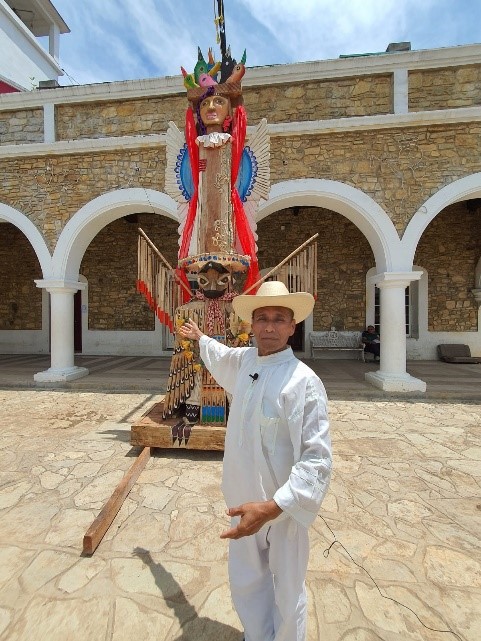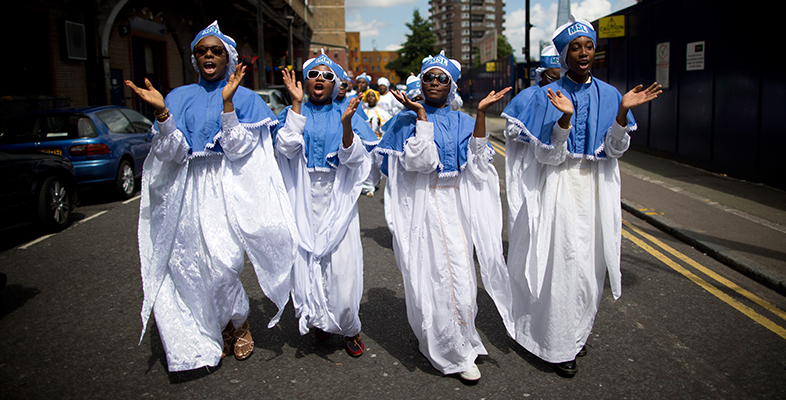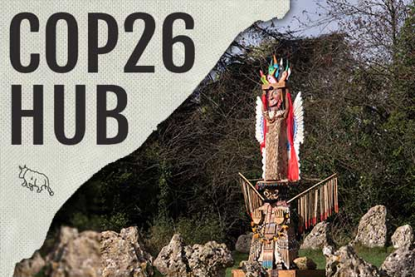 Jun Tiburcio with Totem Latamat
Jun Tiburcio, a Totonac multidisciplinary artist from the Mexican state of Veracruz, has felled and carved a tree into a totem that is travelling to Glasgow for the COP26 meeting. Tiburcio and those facilitating the totem’s journey intend to share powerful Indigenous responses to the global challenges confronting us. I’m involved because of my research about the potential of Indigenous ceremonies and festivals to making a better world.
Jun Tiburcio with Totem Latamat
Jun Tiburcio, a Totonac multidisciplinary artist from the Mexican state of Veracruz, has felled and carved a tree into a totem that is travelling to Glasgow for the COP26 meeting. Tiburcio and those facilitating the totem’s journey intend to share powerful Indigenous responses to the global challenges confronting us. I’m involved because of my research about the potential of Indigenous ceremonies and festivals to making a better world.
Many people are overwhelmed by despair when faced with the enormity of Climate Change and other global challenges. This can even be exacerbated by the magnitude of some of the proposed solutions, especially the most ambitious technical ones. Something needs to intervene between the disasters presented by global and social media and the debilitating mood that prevents individuals and nations from doing enough, fast enough. What is needed is acts and arts which inspire more ecological engagement with a world worthy of celebration.
The journey of the Totonac totem carving, called Latamat (Life), is part of the Border Crossings’ ORIGINS Festival of First Nations. This is a biennial event that normally brings Indigenous performers, films, arts and events to London for a few summer weeks. Many of its performance events are inspired by traditional ceremonies and teachings. Indeed, the festival always includes ceremonies as these are key ways in which Indigenous people express respect for the larger-than-human world.
In 2015 ORIGINS Festival involved another Totonac event. The Voladores (Birdmen) de Papantla erected a tall pole in a park near the Grenville Tower, London, and the performers enacted a 1500-year-old ceremony originally intended to end a long-lasting drought. While one person stood on a small platform at the top of the pole, four others, roped to the pole, “flew” to the ground in unfurling spirals. You can see part of this in an extract from an OU film made about the festival: “Indigenous in London”.
This year, because of the Covid pandemic, the festival is extended temporally and geographically, continuing into 2022 and hosting events beyond London. It will highlight the interlinked themes of Covid, Climate Change and Colonialism. This is the context for the Latamat totem’s journey to Glasgow – with stopovers in other UK venues to inspire interest among the public and media. It is intended to generate understanding of Indigenous experiences and perspectives and to increase a sense of urgency in confronting the core issue of COP26: global climate change.
Indigenous communities are among those most affected by Climate Change. As sea levels rise and forests burn, as the Arctic warms and wildlife suffers, many places and ways of living are becoming difficult or impossible.
As Kyle Whyte (Professor of Environment and Sustainability at the University of Michigan) says, Indigenous people have had to adapt to dramatically altered environments and climates ever since the apocalyptic colonisation of the world by Europeans. Whyte’s Potawatomi nation ancestors were forcibly removed from their forested territory to the arid lands of Oklahoma in the nineteenth century. Those who survived the relocation found resources for resilience in traditional environmental and cultural knowledges. Ceremonies contribute significantly here because they express and encourage celebration of and gratitude to the larger-than-human community. In turn, this strengthens efforts to protect, preserve and promote healthy ecologies and relations.
The dramatic and colourful totem Latamat portrays and celebrates the endangered life of Earth’s environments and species. At its base is an eagle warrior, a symbol of force, courage, beauty and wisdom among the Indigenous peoples of Mexico. At its top are hummingbirds, symbols of infinite possibilities and the aspiration to improve life for all. Birds are thought of as messengers among the Totonac – inciting us all to “take a flight” to act urgently with others to respect the world. For Jun Tiburcio, the totem’s artist, a central theme is the need to express gratitude for all the gifts that make life possible – including food, water, clothing and the materials given to make our homes.
Latamat does more than remind us of the threat of Climate Change and Mass Extinction. Everyone who encounters the totem on its journey will be encouraged to celebrate their place in the living world. By reminding us to honour and thank our bird, plant, animal, mineral and other relations, the totem may give us deeper reasons to protect and enhance life. This is not a complicated message – but it is a profound one when most of what we hear about climate change is depressing and demotivating. I’m excited to see how this spectacular work of art by an Indigenous carver could contribute to more urgent and determined transformations in our efforts to tackle climate change, mass extinction and the other urgent themes of COP26.



Rate and Review
Rate this article
Review this article
Log into OpenLearn to leave reviews and join in the conversation.
Article reviews